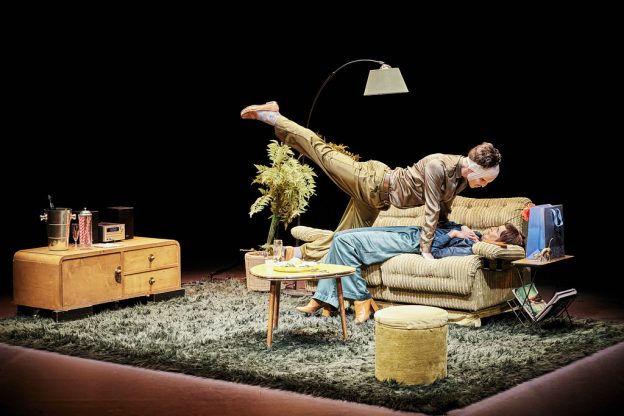‘Death is always present – it reminds us that we are alive.’
This is the mantra of Belgian theatre company Still Life, who present their Avignon Festival hit show Flesh at the London International Mime Festival 2023
Blackout. Ambient electronic music plays. As the lights slowly go up on the stage, we see what might be a lounge bar. Tables and chairs, velvet seating running along the back.wall. Cheery Italian pop music is playing, but the people in the room don’t seem very happy. Two are sitting on chairs set round a central table; a pregnant woman eating crisps, and a leather-jacketed man turned away from her, shoulders hunched. Another man in a dark-coloured suit is pacing up and down nervously, smoking. Mounted on a stand is a large photo of a woman, with a spray of white flowers below. We realise that this is a funeral gathering, a wake. The pregnant woman goes over to a cassette machine and changes the music to something more sombre – perhaps an adagio by Albinoni, that sort of thing. Another woman enters the room, carrying a box. What’s in it?
There are clearly complex, longterm dynamics playing out in this group of people – niggles, grudges, jealousies, rivalries. The piece builds very slowly. A terse, psychological acting out of family relationships descends little by little into an out-and-out farce featuring physical fighting, flying ashes, and alternating manic laughter, hysterical crying and primal screaming. All of this is played out as a wordless drama, with a Mike Leigh meets early Complicite kind of vibe.
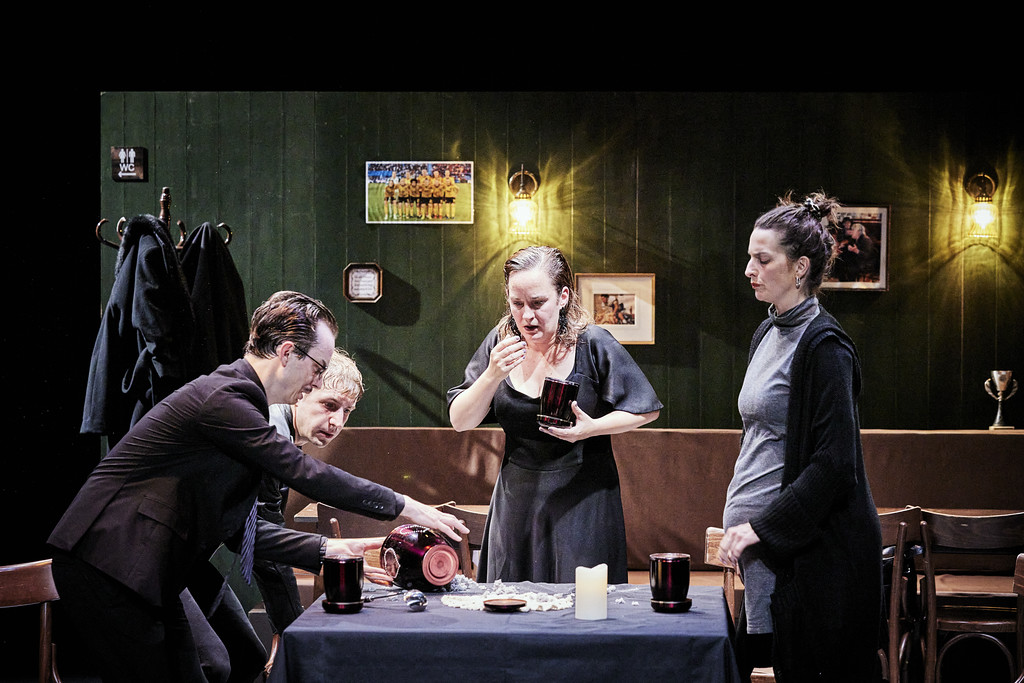
The piece is one of four vignettes that together make up the show Flesh, which is coming to the Barbican for the London International Mime Festival 2023, after playing to great acclaim at the Avignon Festival 2022. The show is what the Lecoq trained company Hoipolloi always talked of as situation-driven theatre: each of the four pieces takes one key scenario and works through it with a meticulous care for detail. The central idea is the driver. What if we place four warring siblings in a room with their mother’s ashes? What rituals do we need to go through in these pandemic-determined days to be allowed in to see a dying relative in an ICU? Each of the four pieces, in one way or another, deal with death or transformation of the human body.
Flesh is created and presented by the Belgian company Still Life, founded and co-directed by Sophie Linsmaux and Aurelio Mergola.
‘We do everything together,’ say Aurelio and Sophie when I meet with them online. ‘One mind with two bodies.’
Both of them had conventional text-based theatre backgrounds, but having finished their conservatoire training, met as young practitioners attending a three-week-long workshop at the Avignon Festival, 20 years ago. Deciding they wanted to work together, they formed Still Life as a company with ‘the body at the core’. They have created a repertoire of works that are predominantly wordless, but most definitely theatre rather than dance or mime.
The first show they made together was about death – which turns out to be a recurring theme in their work.
‘We were just young adults, but aware that death seemed to have disappeared from our society,’ says Aurelio. ‘We wanted to make something about death that was funny and playful.’ What emerged was Où les hommes mourraient encore, set in a fictional land where death has disappeared, exploring what happens when a trio of friends encounter its return.
Sophie takes up the story, mentioning the company’s second show, Keep Going – a show which set the trend for titling their work in English.
‘We wanted to make people look differently at the world – to create a theatre without words that was meaningful,’ she says.
An interesting reflection, as one of the barbs traditionally thrown at physical/visual theatre is that it is hotter on form than on content.
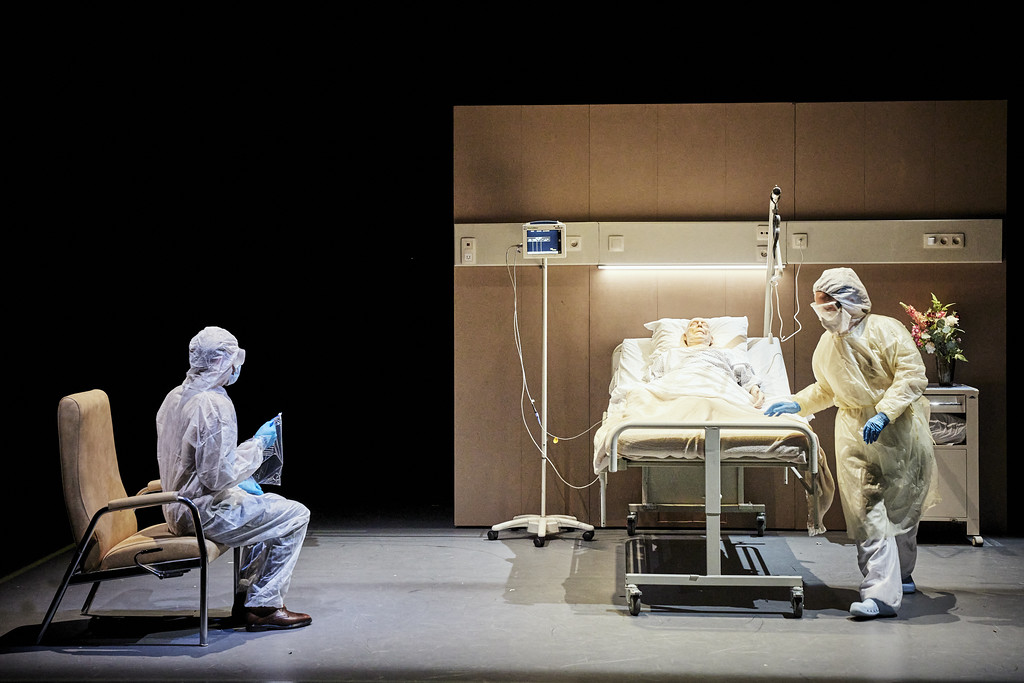
Throughout the years, the company have maintained an ongoing relationship with Avignon Festival. In 2015 they, along with a number of other young Belgian theatre-makers, were commissioned to create a short-form outdoor piece – Frozen was the result. This was later developed into a longer version. Still Life returned to the festival numerous times, and were commissioned to create a new full-length piece called No One for the 2020 festival. It premiered in February 2020 at the Théâtre les Tanneurs in Brussels (where the company are based, and supported as artists in residence), and went to a few other Belgian venues, but then had to be abandoned when the Avignon Festival 2020 got pulled because of the pandemic.
‘It was terrible,’ says Aurelio. ‘We were crying!’ And it turned out that in 2021, the moment had passed for No One, so it never made it to Avignon. But they got over it, moved on, and decided to create a new work made up of short-form pieces, which resulted in Flesh. And this was indeed presented at Avignon Festival 2022, bringing the connection full-circle from that first workshop 20 years ago to a fully-fledged, full-length production.
Over the past two decades, the core company has expanded to include administrative director Marion Couturier, and technical director Nicolas Olivier.
Other regular contributors to the work – constants for all Still life shows made in the past ten years, says Sophie – are Thomas van Zuylen, co-writer and dramaturg; choreographer/movement director Sophie Leso; and set designer Aurélie Deloche. They are joined on this production by lighting designer Guillaume Toussaint-Fromentin, adding another crucial element to the scenography. Aurelio and Sophie both say that working with the same core team over many years really enhances their work.
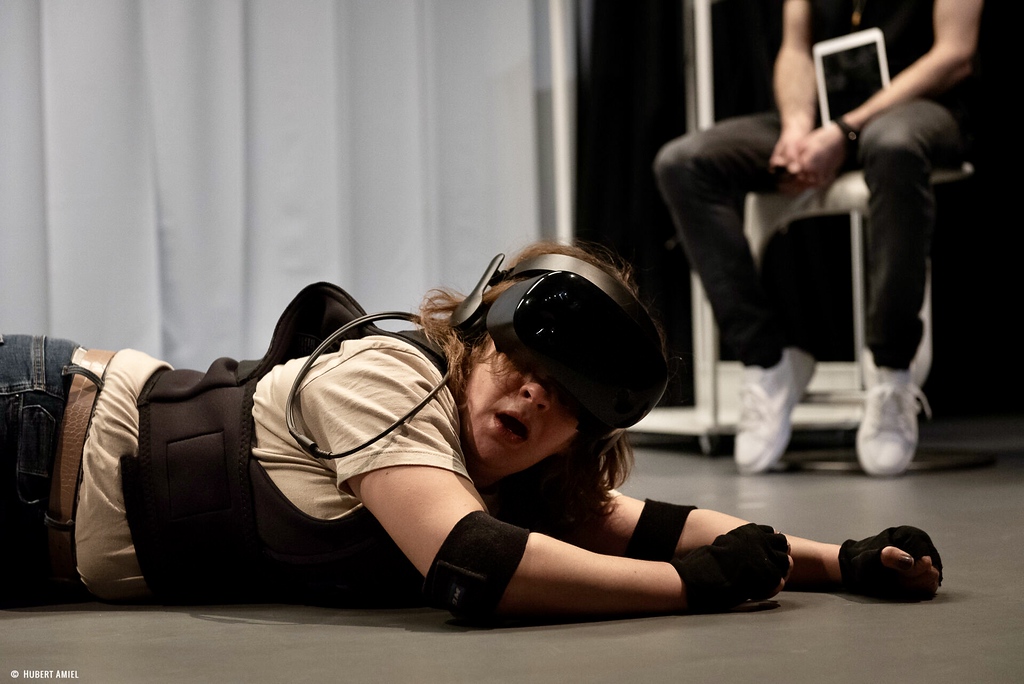
I’m very interested to learn how important the writing process is for the company. We often think of word-free theatre as something that develops from a devising session in an empty space – but that’s not the case for Still Life.
‘Everything starts with a dialogue between the two of us,’ says Aurelio. ‘Then we write.’ Aurelio and Sophie will have an idea or a question, which might perhaps be inspired by a novel, or by an image from an art exhibition. Both are fans of the work of sculptor Ron Mueck (he of the ‘Dead Dad’ sculpture notoriety).
‘We like the way Ron Mueck’s work seems realistic, but is actually fake – we try to pull those two things together in what we create onstage,’ says Aurelio.
Talking about taking their cue from the world of visual arts, Sophie says: ‘Vision is vital! We want people to really look at what they are being given; to really see…’
Once an idea has been talked through, and initial writings done, then they bring in dramaturg and co-writer Thomas Van Eyen. Thomas comes from a film background, and uses scripting techniques developed from cinema. In what Aurelio calls a ‘ping pong’ process between the three of them, they develop a very detailed script in which staging, visual imagery, physical action, music, sound effects, and lighting are all detailed.
‘We write in everything before we step into the rehearsal room,’ says Aurelio.
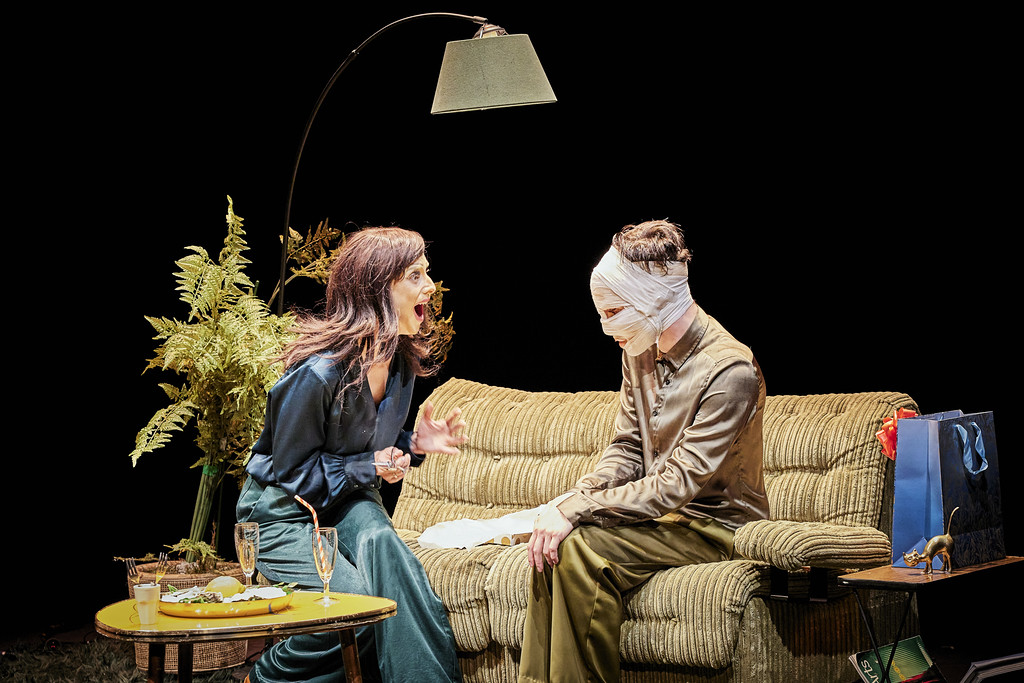
We then move on to talking about the process of creating Flesh. I ask Aurelio and Sophie whether the four separate tableaux (or short-form pieces, as they prefer to call them) were always intended to be shown together; and how they were developed.
‘We started off writing many more than four, just trying out different ideas around the theme of the body – its presence and absence,’ says Aurelio. ‘It was during the pandemic, so the fact that people could not touch each other was informing the work.’
They then sent on the first-draft pieces to Thomas who interrogated the writings, and together the three of them picked out the four pieces they wanted to develop; the ones that best foregrounded the theme of the body’s presence or absence; endurance or transformation. They later worked out the best order for the pieces – the one that would take the audience on the strongest journey. The first piece investigates the dying body; the second is about modifying the body through plastic surgery; the third investigates the dissociation between body and mind, as played out through a VR experience; and the fourth piece explores re-connecting where there has been disconnection. The work is performed by a four-person team of actors – including Sophie and Aurelio themselves.
One of the crucial elements of Flesh, as for much visual theatre, is the sound design. This is by Eric Ronsse, who is working for the company for the first time. The show features an interesting mix of pre-existing tracks, composed electronic music, and ambient sound.
Talking of sound, Sophie emphasises the role that silence plays in the work, and we talk about the fact that theatre-makers need to be brave about such things, and to trust that audiences can handle silence, stillness and space.
Something that comes up a lot when people review Still Life’s work is the word ‘visceral’. It is very hands-on, physical work. In Flesh, we are not encountering surreal, ambivalent landscapes – the company create tangible environments, peopled by very real and present physical bodies, and then add a twist to the tale.
‘We always start our stories with something the audience knows,’ says Aurelio. ‘For example, in the first piece, the audience all have a collective memory of what a hospital room looks like, so they recognise the scene, and its associated emotions, immediately.’
So the audience are not made to do loads of work trying to identify where the scene is set. It is the situation in which the human occupants of this scenario find themselves in that is the key factor – and how they then respond to it.
‘Some things are both terrible and funny,’ adds Sophie, ‘and this interests us.’
It is this juxtaposing of seeming opposites – the terrible and the funny, the real and the imitation, the present and the absent – that is at the heart of the company’s work.
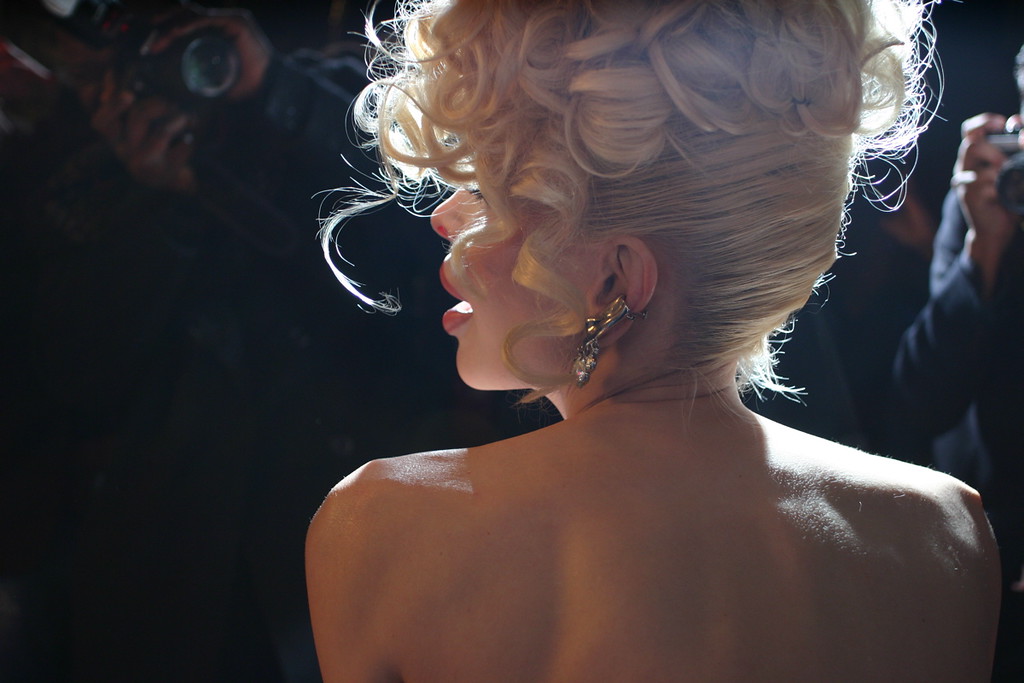
Featured image (top): Still Life: Flesh (part 2). Photo Christophe Raynaud de Lage.
Flesh by Still Life premiered at Théâtre les Tanneurs in Brussels in February 2022, and was performed at the 76th edition of Avignon Festival in July 2022.
It comes to the Barbican 25–28 January 2023 as part of the London International Mime Festival. Book tickets here.
For more about the company, see http://still-life.be
London International Mime Festival (LIMF) is an established, annual festival of contemporary visual theatre. Essentially wordless and multi-disciplinary, its programme embraces circus-theatre, puppetry/animation, object theatre, mime, live art and physical theatre.
LIMF takes place in venues across London from Monday 16 January till Sunday 5 February 2023. For full details of all theatre shows, film screening and workshops in this year’s programme, and to book, see https://mimelondon.com/

